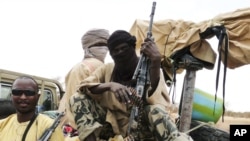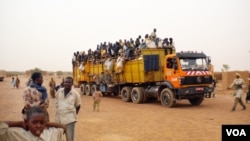Militias in northern Mali say they have united to fight off the Tuareg and Islamist rebels that seized control of the region in early April. Though their activities have so far been minimal, the alliance between these militia groups has raised fears of inter-communal violence in the north.
The Northern Mali Liberation Front, known by its French acronym FLNM, unites three main militia groups in the region: two Songhai militias, the Ganda Koy and the Ganda Izo, as well as fighters under the command of a Tuareg army colonel El Hadji Gamou.
The FLNM was formed in May in opposition to separatist Tuareg rebels and Islamist militants who seized control of northern Mali following a chaotic military coup in Bamako on March 22.
Idrissa Fall of VOA's French service interviewed the FLNM's military chief, El Kahedi Cisse, in Gao this month.
Cisse says they have waged two successful attacks against Islamist militants. He says the militias are employing guerrilla warfare, what he called a "one against ten" strategy against their adversaries, who he said are armed with machine guns, rocket launchers and other heavy weapons. Cisse says they plan to intensify their attacks. He says all three groups of the FLNM have the same objective: to liberate northern Mali. He says they will remain active so long as the territory is occupied.
Mali's central government in Bamako has long used proxy militias, like the Ganda Koy, to contain Tuareg rebellions and insecurity in the largely ungoverned northern reaches of the country. Tuaregs are not the majority in northern Mali, which is also home to Arab, Songhai, Peul and Fulani groups.
Trouble Began in January
This most recent round of trouble in the north began in January when Tuareg separatist group, the MNLA, launched a fight for independence. The Malian army suffered several bitter defeats. Anger at the government pushed soldiers to mutiny and then overthrow the government of president of Amadou Toumani Toure on March 22nd. The MNLA, joined by a radical Islamist offshoot Ansar Dine, quickly seized control of three northern capitals in early April.
The Malian army is struggling to reorganize following the coup, and the future of the interim civilian government in Bamako remains uncertain. West African leaders have opened separate negotiations with the two occupying forces and are formulating plans for a regional military intervention, should talks fail.
The FLNM secretary general, Saidou Amadou Cisse, told Fall in Niamey that negotiations over the future of northern Mali that exclude the Songhai ethnic group are "doomed."
Cisse says the FLNM includes members of the Arab, Songhai and Tamasheq, which is commonly known as the Tuareg, communities in the north. He says negotiations with the MNLA and Ansar Dine that are taking place in Burkina Faso do not concern them. He says talks should come after military action. He says negotiations can happen when these two groups leave the towns.
The Ganda Koy militia was created by former Malian soldiers in opposition to the Tuareg rebellions of the 1990s. The Ganda Izo is an offshoot, or some say a successor, to the Ganda Koy. The militias include members of so-called dark-skinned ethnic groups in the North: the Songhai, Peul and Fulani.
Colonel El Hadji Gamou is a Tuareg from the Imghad ethnic group. He was the most senior Malian military officer in the north and the leader of a pro-government militia. He feigned joining the MNLA in April and then fled with his men, reported to number a few hundred, to safety in Niger. Colonel Gamou has repeatedly voiced his willingness to help retake the north.
Yvan Guichaoua, lecturer at the University of East Anglia in Britain, has done extensive research on Tuareg movements in Niger and Mali.
He says there are two ways to interpret news of the FLNM.
"First, it's people who are willing to fight who just want to signal that they are happy to be armed if anyone wants to give them arms. That's the first interpretation. The second could be that they have received some support and they might be operational. But right now, nothing has happened on these fronts. But you can clearly see that there is a project of counterinsurgency through proxy militias, unaccountable proxy militias, consolidating. That would be a dramatic and very unwelcome shift to the current conflict that could basically mean tribal war," Guichaoua said.
He says the closed-door negotiations between rebel leaders and Burkinabe president, Blaise Compaore, in the absence of Malian authorities, could be catalyzing these grassroots stirrings of counter-insurgency in the North.
End of Peace Agreement
The peace agreement that ended the 1990 Tuareg rebellion was contested, he said, by other groups in the north who felt excluded, ultimately leading to violence.
"There was a shift in the 90s. The rebellion led by the Tuareg transformed into a very nasty inter-tribal war between Tuareg groups -- some loyal to Bamako, some still contesting Bamako's hegemony -- and non-Tuareg groups, particularly the Ganda Koy," Guichaoua said.
The Ganda Koy, he said, are known for extreme violence and human rights abuses, including killing civilians.
"They have a dark history, these militias. Are people in Bamako or maybe outside Mali maybe ready to arm these people? That is the key question," Guichaoua said.
Meanwhile, frustration is mounting in northern towns, where residents have taken to the streets repeatedly to protest occupying forces.
The Northern Mali Liberation Front, known by its French acronym FLNM, unites three main militia groups in the region: two Songhai militias, the Ganda Koy and the Ganda Izo, as well as fighters under the command of a Tuareg army colonel El Hadji Gamou.
The FLNM was formed in May in opposition to separatist Tuareg rebels and Islamist militants who seized control of northern Mali following a chaotic military coup in Bamako on March 22.
Idrissa Fall of VOA's French service interviewed the FLNM's military chief, El Kahedi Cisse, in Gao this month.
Cisse says they have waged two successful attacks against Islamist militants. He says the militias are employing guerrilla warfare, what he called a "one against ten" strategy against their adversaries, who he said are armed with machine guns, rocket launchers and other heavy weapons. Cisse says they plan to intensify their attacks. He says all three groups of the FLNM have the same objective: to liberate northern Mali. He says they will remain active so long as the territory is occupied.
Mali's central government in Bamako has long used proxy militias, like the Ganda Koy, to contain Tuareg rebellions and insecurity in the largely ungoverned northern reaches of the country. Tuaregs are not the majority in northern Mali, which is also home to Arab, Songhai, Peul and Fulani groups.
Trouble Began in January
This most recent round of trouble in the north began in January when Tuareg separatist group, the MNLA, launched a fight for independence. The Malian army suffered several bitter defeats. Anger at the government pushed soldiers to mutiny and then overthrow the government of president of Amadou Toumani Toure on March 22nd. The MNLA, joined by a radical Islamist offshoot Ansar Dine, quickly seized control of three northern capitals in early April.
The Malian army is struggling to reorganize following the coup, and the future of the interim civilian government in Bamako remains uncertain. West African leaders have opened separate negotiations with the two occupying forces and are formulating plans for a regional military intervention, should talks fail.
The FLNM secretary general, Saidou Amadou Cisse, told Fall in Niamey that negotiations over the future of northern Mali that exclude the Songhai ethnic group are "doomed."
Cisse says the FLNM includes members of the Arab, Songhai and Tamasheq, which is commonly known as the Tuareg, communities in the north. He says negotiations with the MNLA and Ansar Dine that are taking place in Burkina Faso do not concern them. He says talks should come after military action. He says negotiations can happen when these two groups leave the towns.
The Ganda Koy militia was created by former Malian soldiers in opposition to the Tuareg rebellions of the 1990s. The Ganda Izo is an offshoot, or some say a successor, to the Ganda Koy. The militias include members of so-called dark-skinned ethnic groups in the North: the Songhai, Peul and Fulani.
Colonel El Hadji Gamou is a Tuareg from the Imghad ethnic group. He was the most senior Malian military officer in the north and the leader of a pro-government militia. He feigned joining the MNLA in April and then fled with his men, reported to number a few hundred, to safety in Niger. Colonel Gamou has repeatedly voiced his willingness to help retake the north.
Yvan Guichaoua, lecturer at the University of East Anglia in Britain, has done extensive research on Tuareg movements in Niger and Mali.
He says there are two ways to interpret news of the FLNM.
"First, it's people who are willing to fight who just want to signal that they are happy to be armed if anyone wants to give them arms. That's the first interpretation. The second could be that they have received some support and they might be operational. But right now, nothing has happened on these fronts. But you can clearly see that there is a project of counterinsurgency through proxy militias, unaccountable proxy militias, consolidating. That would be a dramatic and very unwelcome shift to the current conflict that could basically mean tribal war," Guichaoua said.
He says the closed-door negotiations between rebel leaders and Burkinabe president, Blaise Compaore, in the absence of Malian authorities, could be catalyzing these grassroots stirrings of counter-insurgency in the North.
End of Peace Agreement
The peace agreement that ended the 1990 Tuareg rebellion was contested, he said, by other groups in the north who felt excluded, ultimately leading to violence.
"There was a shift in the 90s. The rebellion led by the Tuareg transformed into a very nasty inter-tribal war between Tuareg groups -- some loyal to Bamako, some still contesting Bamako's hegemony -- and non-Tuareg groups, particularly the Ganda Koy," Guichaoua said.
The Ganda Koy, he said, are known for extreme violence and human rights abuses, including killing civilians.
"They have a dark history, these militias. Are people in Bamako or maybe outside Mali maybe ready to arm these people? That is the key question," Guichaoua said.
Meanwhile, frustration is mounting in northern towns, where residents have taken to the streets repeatedly to protest occupying forces.


